2011 Chevrolet Cruze – Click above for high-res image gallery
Chevrolet's mainstream, high-volume compact car was derisively referred to as the Cadavelier not so many years ago. It was considered one of the most uninspired entries from any automaker in the segment. The Cobalt was a major step forward, but still wasn't near the top of its class. In the words of soon-to-retire General Motors vice-chairman Bob Lutz, the Cobalt was developed under the old philosophy of making cars "good enough."
Under Lutz's tutelage, GM's product development team has shifted to a philosophy of making its products "Best in Class." Transitions like this don't happen overnight, though – especially in the car business with its long lead times. While some would argue about whether GM's newest offerings are segment leaders, there is no doubt that almost every recent GM introduction has made tremendous progress.
GM will launch a replacement for its one-and-done Cobalt later this year in the shape of the new Chevrolet Cruze. We were invited to the GM Milford Proving Ground to learn more about the Cruze and get a first drive on the track. Read on to find out if it indeed has a shot at being best in class.
Ever since we first saw the Cruze just before the 2008 Paris Motor Show, GM has been saying that it is not a direct replacement for the Cobalt since it is larger and more upscale than the outgoing compact. In fact, the Cruze is less than one inch longer than the Cobalt and an inch taller. The biggest difference lies in its wheelbase and width, where the new sedan has an advantage of 2.4 and 2.8 inches respectively. Chevrolet will promote the Cruze as offering near mid-size space in a compact package with a compact price.
The Cruze is built on GM's new global compact platform (a.k.a. Delta II), which it shares with the Opel/Vauxhall Astra, the Volt, upcoming models including the Orlando and the next-generation Opel Zafira. Development of this platform was truly a global effort, with work being conducted around the clock from 2006 onward in South Korea, Germany and the United States. The Cruze is already on sale in more than 60 countries after launching in South Korea and China in late 2008, and it will go on sale in North America in the fourth quarter of this year.
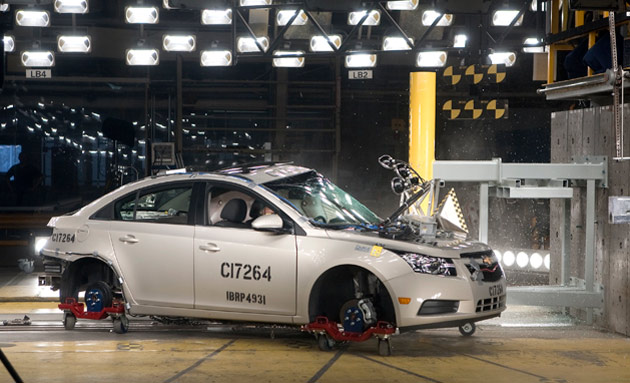
The Cruze engineering team focused on several areas during development including refinement, safety and efficiency. We'll be taking a closer look at the safety story in a separate, more in-depth piece, but the car has been designed to meet all divergent safety requirements for each market in which it's sold and does so with one common structure. Crash tests in the Korean, Chinese and European NCAP programs have all yielded five star safety ratings, with the European Cruze scoring best-ever results in its segment in the EuroNCAP. The Cruze is also the first compact with 10 standard airbags, including front knee airbags and even rear seat outboard side airbags.
Remarkably, it does this without getting ridiculously heavy or resorting to the thick visibility-sapping pillars found on the Buick LaCrosse. GM has not announced the weight of the Cruze, but one engineer did say that loaded models would be in the 3,375-pound EPA test weight class, so that would likely put it somewhere between 3,125 and 3,375 pounds. The new body structure is also substantially more rigid than previous Delta platform vehicles. It now has a natural frequency of 42 Hz in bending and 40 Hz in twisting, an improvement of between 10-to-40 percent.
GM offers several different engine and transmission options for the Cruze in other markets, but the U.S. model will be the first to be equipped with six-speed units across the board. The new in-house developed-and-built M32 six-speed manual (below, left) will see its first application in the compact, as will an all-new six-speed automatic. The new 6T40 automatic transmission (below, right) is particularly compact and will eventually find its way into smaller GM cars around the world.
On the engine side, North America will only be getting the 1.8-liter inline four-cylinder engine, which is standard in the base LS model, and the new 1.4-liter turbocharged four-cylinder for the LT, LTZ and ECO models. While both produce similar power (136 horsepower for the 1.8 and 138 hp for the 1.4), the smaller turbocharged engine has a substantially fatter torque curve hitting 148 pound-feet at 1,850 rpm (123 lb-ft at 3,800 rpm for the 1.8) and staying there throughout most of its operating range. (Update: The 1.4-liter turbo uses port fuel injection rather than direct injection. GM was able to meet its performance and efficiency targets for the engine without the extra cost of DI. GM engineers don't rule out using DI on future iterations of the engine.)
The turbocharged 1.4-liter engine (below, right) also has some interesting design features. Unlike many modern engines, it retains a cast iron block. However, this is a thin wall casting that has almost no weight penalty over an aluminum design because it doesn't need any cylinder liners. As you go to smaller engines, the benefits of the lighter material shrink because of the extra material that must be added for durability reasons.
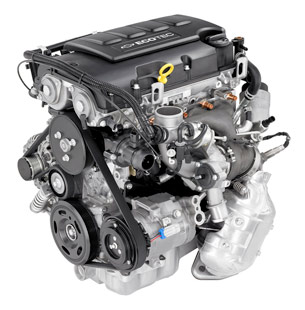 Engine weight is also kept down by using a composite intake manifold and a single-piece cast aluminum front cover with an integrated water pump. Parasitic losses are reduced by using a variable displacement oil pump to only produce as much oil pressure as needed rather than building excess and then using a bypass to bleed it off. Instead of a traditional screw-on oil-filter, the 1.4 has a cast-in housing with an integrated cooler and a replaceable paper cartridge filter that comes out from the top. This reduces oil spillage during changes and has less waste material during disposal. The manual-equipped 1.4-liter model also gets a dual mass flywheel, which helps to dampen vibrations from the four-cylinder engine.
Engine weight is also kept down by using a composite intake manifold and a single-piece cast aluminum front cover with an integrated water pump. Parasitic losses are reduced by using a variable displacement oil pump to only produce as much oil pressure as needed rather than building excess and then using a bypass to bleed it off. Instead of a traditional screw-on oil-filter, the 1.4 has a cast-in housing with an integrated cooler and a replaceable paper cartridge filter that comes out from the top. This reduces oil spillage during changes and has less waste material during disposal. The manual-equipped 1.4-liter model also gets a dual mass flywheel, which helps to dampen vibrations from the four-cylinder engine.
The Honeywell supplied turbo itself is integrated into the exhaust manifold to minimize energy loss and lag, which helps with the engine's responsiveness. Coolant flow is maintained through the turbo bearing area after engine shutdown to prevent the oil from cooking and prematurely destroying the turbo.
The Cruze's front suspension is a fairly conventional MacPherson strut setup, but the electric power steering (EPAS) is now rack-mounted rather than column-mounted for better feel. Hydraulic bushings are used in the lower control arms for better ride and isolation and hydraulic load-bearing engine mounts are also used to keep noise and vibration from being transmitted into the passenger compartment.
At first glance, the torsion beam rear suspension looks pretty unimpressive, but chassis engineers have incorporated some interesting features. Because the Delta II platform is designed to be sold in markets around the world with various bodystyles, flexibility was needed to tune the suspension for various applications. A typical torsion beam setup has a lateral V-shaped beam joining the trailing arms. The Cruze (and other Delta models including Astra and Volt) has a steel tube with a pinched central section, and GM uses a patented helical welding process at the outer ends to connect the beam and control arms.
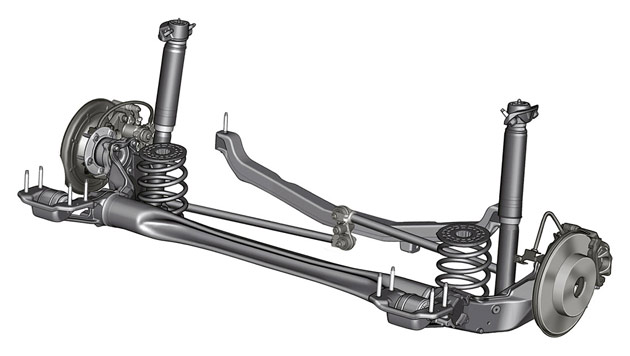
The beam itself provides the roll control function of an anti-roll bar. By varying the thickness of the steel in the tube, the engineers can adjust the car's rear roll stiffness. The tube can also be rotated for different vehicles to change the orientation of the pinched section. By doing this, the roll steer effect of the rear axle (the angle of the wheels as they move up and down that affects the handling of the car) can be changed. A Watts link has also been incorporated to help manage the lateral position of the wheels, the first such application with a torsion beam axle in a production car. A lateral link from the rear end of each trailing arm is attached to the central crank mounted to a sub-frame. As lateral loads build, the linkage puts a counter-acting force on the opposite wheel to keep the whole setup centered under the car.
Minimizing noise, vibration and harshness (NVH) was also a top priority throughout development of the Cruze. Along with the usual array of sound-deadening mattes, the engineers have also used features typically found on more premium cars like acoustical windshield glass and triple door seals. During the body build process, expanding foam is injected into hollow sections of the doors and body structure. When the body goes through the curing ovens after painting, the foam expands to fill those areas so that it can dampen out vibrations.
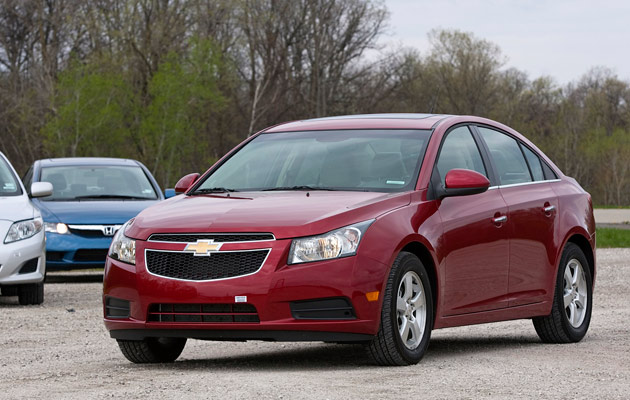
GM provided three Cruze models for us to drive at the Milford Proving Ground ,along with a Toyota Corolla and two Honda Civic sedans for comparison. One Cruze was a loaded LTZ model with the six-speed automatic transmission, 18-inch wheels and sport suspension setup. Another was a mid-level 2LT automatic with 16-inch wheels and touring suspension, while the third was a manual transmission Eco model. All were powered by the new 1.4-liter turbo. These were engineering development cars and didn't necessarily have all the final trim and graining in the interior, so we'll withhold final judgment on interior fit and finish until we can get our mitts on a production example. We were told, however, that the NVH package and mechanical bits were pretty much finalized on these cars.
Given the relatively modest growth in external size, the Cruze is quite roomy inside, now being classed as a mid-size car by EPA standards. Four adults can easily fit comfortably in the front and back. Like most other recent GM cars, the front seats are quite comfortable and supportive with adequately long seat cushions for decent thigh support.
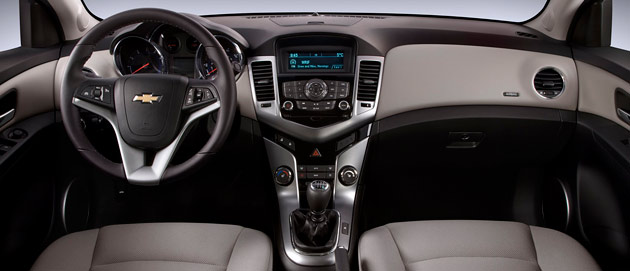
While fit and finish on our test cars wasn't representative, the layout was. The arrangement of controls is very good, with knurled rubber coatings on the big round knobs for the audio and climate controls. The gauges are large and legible and a full driver information display sits in between the speedometer and tachometer, just as it does on other GM vehicles.
We were allowed to lap the ride-and-handling loop at Milford in all of the cars as well as check out acceleration and braking in the vehicle dynamics area. The first car we tried was the Eco model, which GM expects will get a 40 miles-per-gallon highway rating from the EPA. In addition to a lowered ride height and some weight and aerodynamic tweaks, the ECO also gets different gearing than other Cruze models. Typically with these fuel economy specials, the gearing is set up just for maximum efficiency and acceleration is leisurely. However, the Cruze engineers actually opted for a shorter first gear ratio (4.273:1 vs 3.818:1 on the base model) in order to provide better off-the-line performance. Third through sixth gears are all taller than base models, as is the final drive ratio to provide lower engine speeds when cruising.
The Cruze Eco feels surprisingly responsive accelerating away from a start and driving around at urban speeds. Most drivers won't find this car at all unpleasant to drive on a day-to-day basis. The manual transmission was also a pleasure to use with slick transitions from gear to gear and no notchiness at all. The clutch take-up was also smooth and progressive. The broad flat torque curve of the turbo engine is something that American drivers will appreciate, making the 1.4-liter engine feel like a significantly larger engine.
The roughly three-mile long Milford ride loop consists of a variety of turns and surfaces, including smooth asphalt and concrete, rumble strips, railroad crossings, humps and dips and broken pavement typical of some of the worst of Michigan roads. One series of right-left-right curves features some very rough, bumpy pavement that can easily upset a car while cornering. The Cruze took everything we threw at with aplomb. The suspension kept the rubber on the road through those rough pavement corners and soaked up everything without a hint of stepping out or excessive vertical motions.
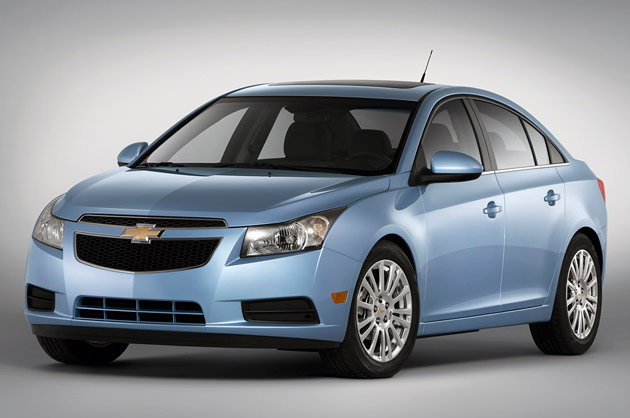
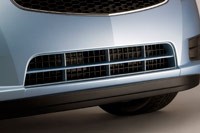
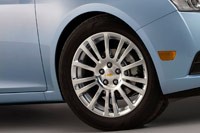
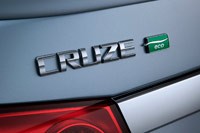
This particular series of corners illustrated the biggest dynamic difference between the Cruze and its competitors. In the same section at similar speeds, the Honda's multi-link rear suspension always seemed to step sideways while the Corolla had under-damped vertical motions. The Cruze was also much better isolated than the other cars. While we could hear what was going on below, the noises were much more muted, providing just enough feedback to act as a warning signal while still allowing a conversation in normal speaking voices.
It was also a real pleasure for us to see the progress being made with newer low rolling resistance tires. Not that long ago, putting such tires on a car would result in handling that felt like you were constantly driving on ice. By contrast, the Cruze Eco always felt confident and in control. The new rack-mounted EPAS system provided a good balance of steering effort whether maneuvering at low speeds or cornering near the limit of adhesion.
Similarly, everything else was quieter in the Cruze – including engine and wind noise. This was particularly true compared to the Civic. Winds were gusting about 25-30 mph during our evaluation and the Civic was shockingly loud inside. By comparison, the Cruze was downright serene. Even though the interior materials of these prototypes was not fully representative, it still looked far better than the interior of the Corolla, which reminded us more of recent Chrysler vehicles than the high-quality cabins that Toyota built its reputation on.
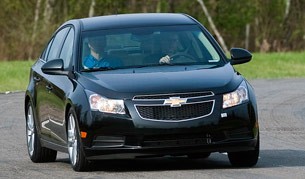
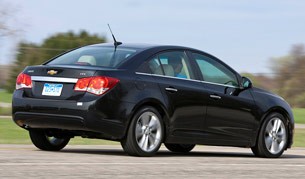
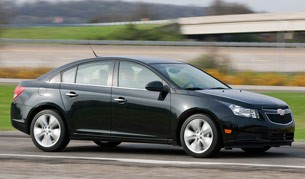
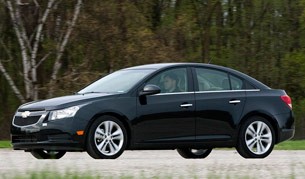
Back on the dynamic front, the two other models we drove exhibited similar handling characteristics to the ECO with the touring suspension 2LT being marginally softer and the sport LTZ having slightly more precise steering response and feedback. The biggest difference from the manual-equipped Eco we drove was the new six-speed automatic transmission, which shifted seamlessly and never exhibited any abrupt behavior. The only real complaint we could make was a bit of sluggishness off the line.
This lag was only momentary and most drivers are unlikely to notice. In fact, it's not much different from what we've experienced in many recent cars that have Normal and Sport shift modes. The Normal mode is typically tuned to maximize EPA numbers with slightly less aggressive throttle and transmission response, while Sport modes typically leap off the line a bit faster. Unless you floor the accelerator, you are unlikely to notice anything untoward.
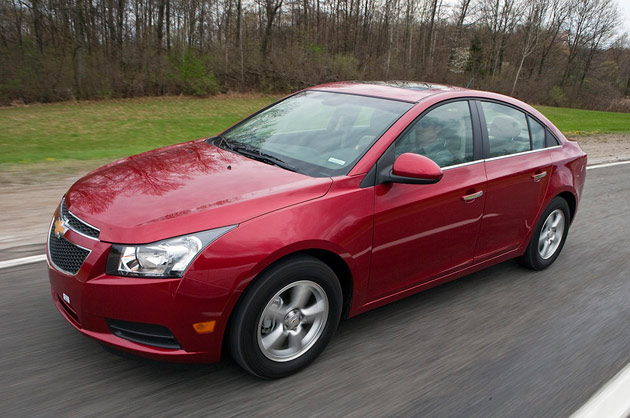
One additional feature new to the 6T40 automatic is an idle-neutral mode. When the vehicle comes to a stop, the transmission automatically goes into Neutral and then re-engages the gear when the brake is released. This reduces load on the engine, adding another incremental improvement to fuel economy. We looked for any signs of this shifting when driving and were unable to detect the transmission's activity.
Overall, our brief exposure to the Cruze showed us that General Motors is serious about being best in class in the compact segment. At first blush, the Cruze has all the makings a huge improvement over the Cobalt, and memories of the Cadavelier will hopefully soon fade. The biggest problem for the Cruze will likely be the new 2012 Ford Focus, which we haven't driven yet. The new Focus is a bit smaller than the Cruze, although is also aiming for a class-leading interior and its styling is arguably more exciting than the Cruze. Regardless, we think there's plenty of room in the compact segment for both cars to succeed, perhaps at the expense of Toyota and Honda.
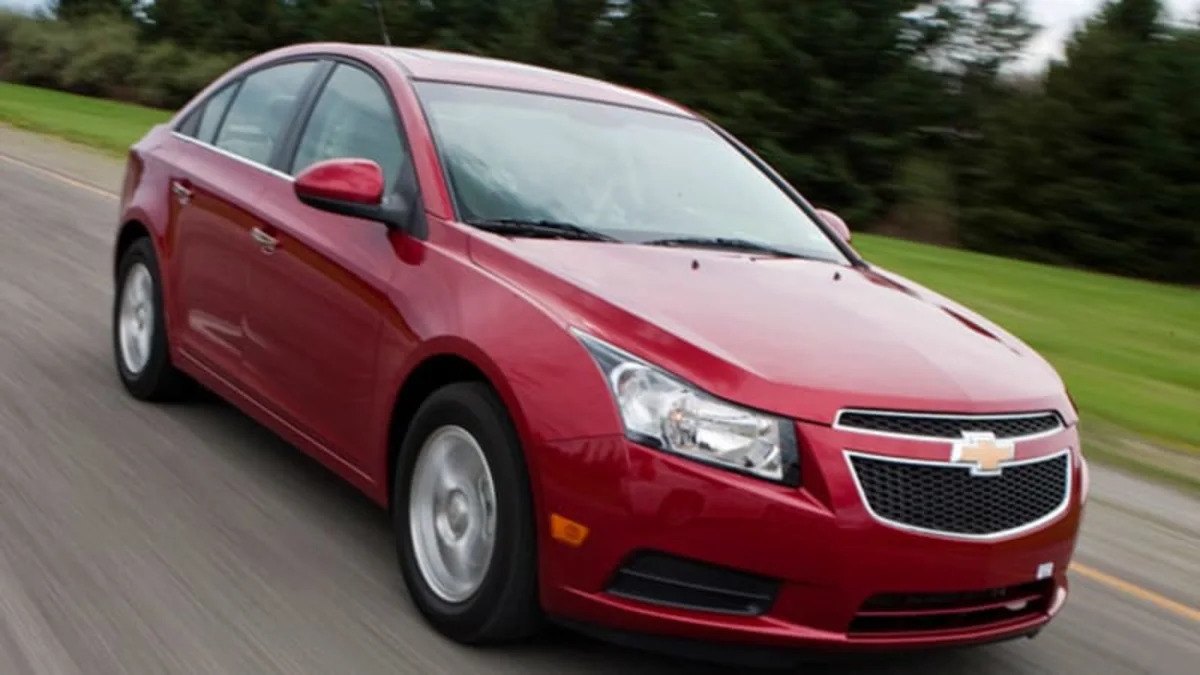
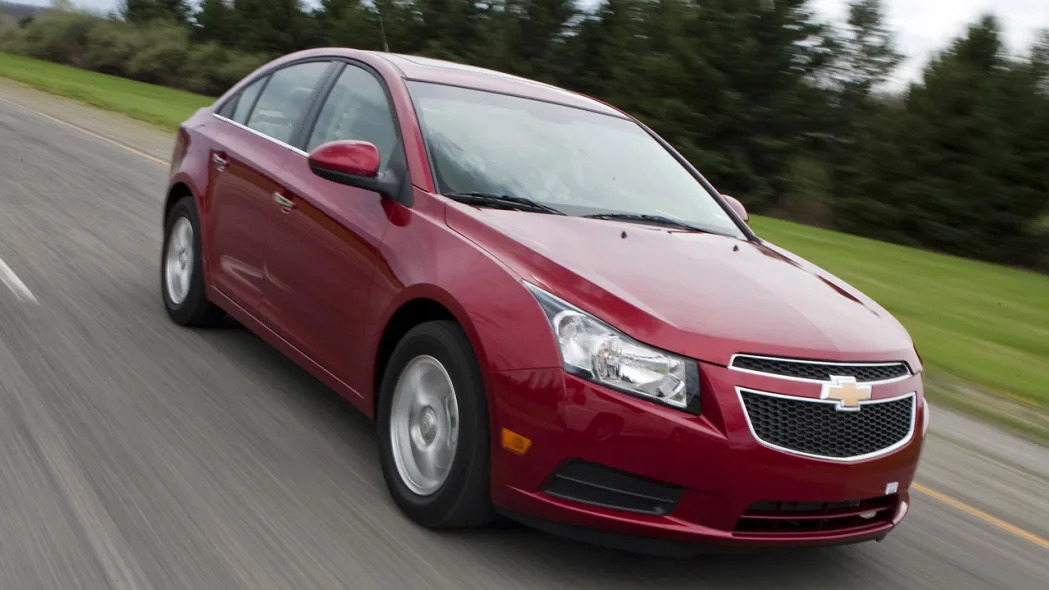
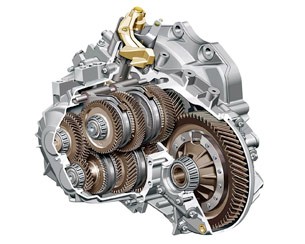
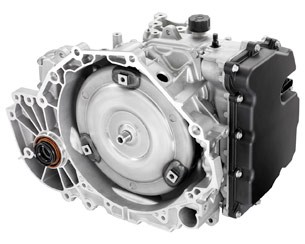

Sign in to post
Please sign in to leave a comment.
Continue